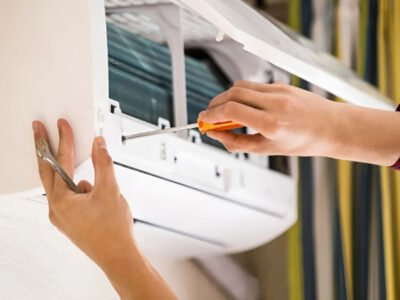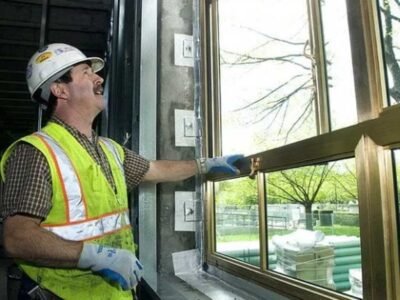Have you noticed your water bill has increased and water usage is higher than normal? Or do you hear drips in the walls or see warped floorboards? A hidden water leak in your wall can cause all of these.
Walls contain many pipes and wires, which increases the chances of water leaks. Often, you cannot detect a leak on your own.
Are you unsure of how to find a water leak inside a wall? Keep reading for our guide on how to spot a leak.
Ways to Trace Signs of Leak
Whether you’re a homeowner or managing a commercial property, learning how to detect the early signs of water leaks can save you from costly repairs and the headache of water damage. Here’s how:
Check for Physical Signs of a Leak
When it comes to discovering and repairing a hidden water leak in your wall, the first step is to carefully examine your surroundings for any physical signs of a leak. Look for any water stains or discoloration on your walls or ceiling, as these can be indications of a leak behind the wall. Similarly, if you notice any bubbling or peeling paint, this could be a sign of a hidden leak.
Listen for Water Sounds
One of the most important steps in locating and fixing a hidden water leak in your wall is to listen for water sounds. These can range from a dripping or running noise to a constant hissing or gurgling sound. To begin, turn off all sources of water in your home and then listen closely to the walls.
If you hear any unusual sounds, use a stethoscope or even just your ear pressed against the wall to pinpoint the exact location of the leak. Ignoring water sounds could lead to costly repairs, so it’s important to actively listen and address any hidden leaks immediately.
Use a Moisture Meter
One effective tool for finding hidden water leaks is a moisture meter. This device measures the level of moisture in your walls and can help pinpoint the source of the leak. To use it, simply press the prongs into the wall and take a reading. If the reading is high, you have found the area in need of repair.
A moisture meter is an essential tool for detecting water leaks in any setting. This instrument is designed to measure the moisture content of various materials such as:
- wood
- drywall
- concrete
Water leaks can go unnoticed for extended periods, causing extensive damage to a building’s structure. However, with the use of a moisture meter, the source of a leak can be identified and repaired before it turns into a major issue.
This device works by detecting changes in the electrical resistance of a material, which can indicate the presence of moisture. By regularly utilizing a moisture meter, homeowners and building managers can prevent costly and potentially hazardous water leaks.
Inspect Nearby Fixtures
When trying to locate and fix a hidden water leak in your wall, it is important to start by inspecting nearby fixtures. This can include sinks, toilets, showers, and any other plumbing fixtures that are located on the same wall as the suspected leak.
Check for any signs of visible water damage such as discoloration surrounding the fixture. If you notice any of these signs, it is likely that the leak is coming from one of these nearby fixtures and can be fixed by addressing the issue directly.
Fixing Hidden Water Leaks
Don’t let hidden water leaks wreak havoc in your home or property. Take control and protect your space from the damaging effects of concealed moisture and unhealthy molds.
Turn Off the Water Supply
The first step in fixing them is to turn off the water supply. This may seem obvious, but many people forget to do this and end up in a flooded house. Turning off the water supply ensures that no more water will flow into the wall, making it easier to locate and fix the leak.
It also prevents further damage from occurring. So, whether it’s a small drip or a major leak, be sure to turn off the water supply before attempting to fix hidden water leaks on walls.
Remove Wall Coverings
One effective way to address hidden water leaks is by removing the wall coverings. This allows for a thorough inspection and repair of the leak’s source.
Turn Off the Water Supply
It is essential to turn off the water supply before attempting to fix the leaks to prevent further water damage and make the repair process easier. By turning off the water supply, you can also accurately locate the source of the leak by eliminating any water flow. This can save time and effort, allowing you to efficiently fix the hidden water leaks and preserve the integrity of your walls.
Open the Wall
One way to access and repair these leaks is by removing wall coverings and opening up the wall. This can be done by carefully cutting away the drywall to reveal the source of the leak.
By opening up the wall, not only can the leak be fixed, but the damaged areas can also be properly dried and treated to prevent mold growth. It is crucial to address hidden water leaks promptly to avoid long-term structural damage and costly repairs.
Identify and Fix the Leak
Inspect the wall’s interior for the specific source of the leak. Common culprits include damaged or leaking pipes, plumbing fixtures, or faulty connections. Repair or replace the component responsible for the leak. If you’re not comfortable with plumbing repairs, consider hiring a professional plumber from Tweedy Plumbing or any reputable ones near you.
Dry and Restore
After fixing the leak, allow the wall’s interior to thoroughly dry. Use fans, dehumidifiers, and proper ventilation to expedite the drying process and prevent mold growth. Once dry, replace insulation, drywall, and wall coverings as necessary. Ensure the repaired area matches the rest of the wall.
Learn How to Find a Water Leak Inside a Wall
Locating and fixing a hidden water leak in your wall can save you time, and money, and prevent further damage to your home. By following the steps outlined in this guide on how to find a water leak inside a wall, you can successfully identify and repair any hidden leaks.
Remember to regularly check for signs of leaks and address them promptly to avoid bigger issues. Don’t wait until it’s too late, take action now and protect your home. So don’t hesitate, take control of the situation and fix that hidden water leak today!
For more articles, visit our blog.
















Comments